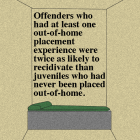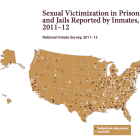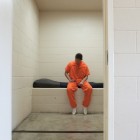
Miller v. Alabama: One Year Later
|
Last year, the Supreme Court declared mandatory life without parole sentences for juveniles to be unconstitutional. A year after the landmark ruling, how have the nation’s juvenile justice systems been impacted?
Juvenile Justice Information Exchange (https://jjie.org/tag/news-system/page/14/)

Last year, the Supreme Court declared mandatory life without parole sentences for juveniles to be unconstitutional. A year after the landmark ruling, how have the nation’s juvenile justice systems been impacted?

I have been out of high school since 1984, and I realize that things these days are different. It was a time when kids were told to punch bullies in the nose (or the solar plexus), when I usually had a knife in my pocket (because that’s what guys did), there were no police at the school, and breaking a rule could get you suspended or expelled, but not handcuffed, and certainly not put in jail. It was the time before Columbine, and the slew of other school shootings that have led us down the path of zero tolerance, anti-bullying, police officers in schools and the related criminalization of actions that would have previously been solved through school discipline. It was a time before wearing a t-shirt could get a kid threatened with fines and jail time, no matter what the shirt said. That is exactly what has happened to Jared Martin, a 14-year-old student at Logan Middle School in Logan City, W.Va.

Texas may soon come into compliance with last year’s Supreme Court ruling barring states from sentencing juveniles under 18 to mandatory life without parole.

New York’s juvenile justice system is slowly being overhauled by Gov. Cuomo’s Close To Home initiative, a set of proposals to keep youth close to their communities.

State legislation proposing to cut the number of juvenile judges from six to four was narrowly defeated Tuesday in a committee vote.

A new report issued by the Pennsylvania Juvenile Court Judges’ Commission finds that among juveniles whose cases were closed in 2007, one-in-five recidivated within two years. The Pennsylvania Juvenile Justice Recidivism Report found juvenile recidivism rates to be as high as 45 percent in some counties, with the average length between case closure and recidivism to be 11.5 months. The younger a juvenile at the time of one’s first written allegation, the study found, the likelier the juvenile was to recidivate. Conversely, the report found that juveniles who were older at the time of case closures were more likely to recidivate than those whose cases were closed at an earlier age. Additionally, juveniles with more formal dispositions on their cases -- such as placement or probation -- were found to recidivate at higher rates than offenders who were given less formal dispositions, such as counseling.

The United States Bureau of Justice Statistics (BJS) released data Thursday revealing new findings about rates of sexual victimization in the nation’s prisons. Advocates claim that the new figures, however, may underreport the amount of juvenile inmate sexual victimizations that goes on in the nation’s jails and prisons.

The Office of Juvenile Justice and Delinquency Prevention (OJJDP) in conjunction with the National Center for Youth in Custody (NC4YC) held a webinar Wednesday titled “Family Comes First: Transforming the Justice System by Partnering With Families.” The online event coincided with the release of a new Campaign for Youth Justice (CFYJ) workbook, which was unveiled on Monday.

This week, numerous legislators and juvenile justice officials testified before Massachusetts’ Committee on Children, Families and Persons with Disabilities, in support of recent legislative proposals that would place 18-year-olds under the jurisdiction of the state’s juvenile courts as opposed to its adult courtrooms.

In 2010, the federal Office of Juvenile Justice Delinquency Prevention released results from the first-ever nationally representative survey of youth confined in juvenile justice facilities. However, because interviews were conducted in 2003, the findings beg the question: What changes have occurred since 2003 in mental health care for confined youth?